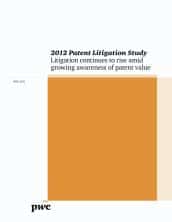With the passage of the Leahy-Smith America Invents Act (AIA) last year, which converted the patent system from a ‘first to invent’ to a ‘first inventor to file’ system. The AIA, signed into law in September 2011, indeed brought significant changes in certain areas. But it did not address the calculation of damages in patent infringement matters, as had been suggested in prior drafts of the bill.
The absence of reform guidance in this regard leaves patent damages issues squarely for the courts. Additionally, the elimination of the 25 percent rule of thumb and rulings in other court decisions demonstrated that the courts, not Congress, would continue to shape the future of patent law and play the primary role in how patent damages are determined.
Without the 25 percent rule of thumb, a complex mathematical proof for determining royalty apportionment, known as the Nash Bargaining Solution, has recently appeared in some patentees’ damages calculations, receiving mixed reviews from the courts. In Oracle v. Google, the Court excluded expert testimony:
“[T]he Nash Bargaining Solution would invite a miscarriage of justice by clothing a fifty-percent assumption in an impenetrable facade of mathematics.”
“Instead, the normal Georgia-Pacific factors, which have been approved by the Court of Appeals for the Federal Circuit and which are more understandable to the average fact-finder, will guide our reasonable royalty analysis.”
Recognizing these developments and business leaders’ continuing deep interest in intellectual property matters, PwC maintains a database of patent damages awards extending from 1980 through 2011. They collect information about patent holder success rates, time-to-trial statistics, and practicing versus nonpracticing entity (NPE) statistics from 1995 through 2011.
New to this year’s study is an analysis of Abbreviated New Drug Application (ANDA) cases, which are increasingly prevalent in the dockets. The volume of such cases has increased substantially over the last five years, and the success rates experienced by the patent holders, or the brand drug manufacturers, have to date been higher than traditional patent actions.
The analysis yields a number of observations that can help executives, legislators, and litigators assess their patent enforcement or defense strategies, as well as the impact of NPEs.


[…] PWC reports sharp rise in patent litigation filings (IP Spotlight) (Patent Baristas) […]
[…] PWC reports sharp rise in patent litigation filings (IP Spotlight) (Patent Baristas) […]